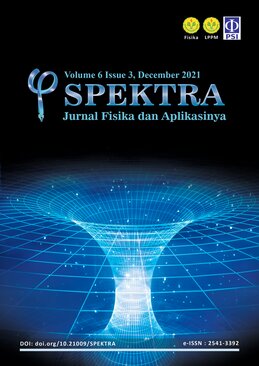WORKING ANALYSIS OF SPACE TIME TRELLIS CODE ON WIFI MIMO(2X2) SYSTEM OFDM
DOI:
https://doi.org/10.21009/SPEKTRA.063.03Keywords:
multiple input multiple output, space-time coding, space-time trellis code, orthogonal frequency division multiplexing, bit error rate, signal to noise ratioAbstract
Wireless communication nowadays requires a system with reliable performance, efficient use of bandwidth, efficient power, and better coverage because it is in line with human needs for applications that require high and fast data rates. One of the concepts and methods to meet these needs is using an antenna technique with many transmitters and receivers or often called Multiple Input Multiple Output (MIMO), by adding a strategy at the time of delivery, namely the Space-Time Coding (STC) technique. In addition, the application of Orthogonal Frequency Division Multiplexing (OFDM) on MIMO-STC will more efficiently use bandwidth. The Space-Time Trellis Code (STTC) method is one of the diverse techniques in sending data with complex coding so that coding reinforcement is achieved and applied to the OFDM MIMO system. It is hoped that a system with reliable performance can be achieved. The simulation that is carried out presents the STTC and OFDM schemes on multi antennas (2 transmitters x 2 receivers) with a Combiner and Maximum Likelihood Sequence Estimator (MLSE) detection algorithm on the receiver. It is to get the quality of the sending signal in the performance analysis of Bit Error Rate (BER) with Signal to Noise Ratio (SNR). The simulation results are shown by modulation with M-array Phase Shift Keying (MPSK) and the number of symbols sent by giving different input parameter values. The results show that the number of carriers and the size of the Fast Fourier Transform (FFT) is large, and the modulation type with a small constellation produces a low BER and throughput at high SNR.
References
[2] Harish Ganapathy, “Multiple Input Multiple Output (MIMO) System, Basic Principles, Algorithms, and Network Application”.
[3] S. Sandhu, R. Heath, A. Paulraj, “Space-Time Block Codes Versus Space-Time Trellis Codes,” Stanford University, Stanford, 2001.
[4] http://www.mathworks.com//Go&objectType=search =awgn
[5] http://www.mathworks.com/matlabcentral/ search&citeria=noise.
[6] Matiae, Dusan. “OFDM as a possible modulation technique for multimedia application in the range of mm waves,” Introduction to OFDM II edition, 1998.
[7] Prasad, Ramjee., “OFDM for Wireless Communication Systems,” Artech House, Boston, London, 2004.
[8] Glisic, Savo, “Advance Wireless Communications 4G Technologies,” John Willey & Sons, Finland, 2004.
[9] Vucetic, Brancka and Jinhong Yuan, “Space Time Coding,” Wiley, England, 2003.
[10] S. Salous, “Multiple Input Multiple Output System : capacity and Channel measurement,” Department Of Electrical Engineering and Electronics UMIST, UK.
[11] THE NON-ENGINEER’S INTRODUCTION TO MIMO AND MIMO-OFDM, http://www.mimo.ucla.edu.
[12] A. Paulraj, “Broadband Wireless The MIMO Advantage,” Stanford University, 2001.
[13] Tarokh, Vahid and A. Robert Calderbank, “Space-Time Block Coding for Wireless Comunication,” IEEE Journal, vol. 17, no. 3, March 1999.
[14] Liang, Yibin, “Simulation of Space Time Trellis Codes,” ECE5654 Final Project Report, 2002.
[15] Amiri, Bahador, “Space Time Trellis Code (STTC),” Winter, 2006.
[16] Alamouti, M. Siavash, “A Simple Transmit Diversity Technique for Wireless Communication,” IEEE Journal, vol. 16, no. 8, October 1998.
[17] Institute of Telecommunication, “Evolution of Mobile Communication,” Techrusche University Hamburg, Harburg.
[18] Haykin, Simon and Moher Michael, “Modern Wireless Communication,” Pearson Prentire Hall, New Jersey, 2005.
[19] Datacom Research Company, “Using MIMO-OFDM Technology to Boost Wireless LAN Performance Today,” White paper ver 1.0, June 1, 2005.
[20] Alexiou, Angeliki and Martin Haardt, “Smart Antennas and Related Technologies Briefing,” Wireless World Research Forum.
[21] Jafarkhani, Hamid, “Space-Time Coding Theory and Practice,” Cambrige University Press, New York, 2005.
Downloads
Published
How to Cite
Issue
Section
License
SPEKTRA: Jurnal Fisika dan Aplikasinya allow the author(s) to hold the copyright without restrictions and allow the author(s) to retain publishing rights without restrictions. SPEKTRA: Jurnal Fisika dan Aplikasinya CC-BY or an equivalent license as the optimal license for the publication, distribution, use, and reuse of scholarly work. In developing strategy and setting priorities, SPEKTRA: Jurnal Fisika dan Aplikasinya recognize that free access is better than priced access, libre access is better than free access, and libre under CC-BY or the equivalent is better than libre under more restrictive open licenses. We should achieve what we can when we can. We should not delay achieving free in order to achieve libre, and we should not stop with free when we can achieve libre.
 SPEKTRA: Jurnal Fisika dan Aplikasinya is licensed under a Creative Commons Attribution 4.0 International License.
SPEKTRA: Jurnal Fisika dan Aplikasinya is licensed under a Creative Commons Attribution 4.0 International License.
You are free to:
Share - copy and redistribute the material in any medium or format
Adapt - remix, transform, and build upon the material for any purpose, even commercially.
The licensor cannot revoke these freedoms as long as you follow the license terms.

 E-ISSN 2541-3392
E-ISSN 2541-3392  Focus & Scope
Focus & Scope  Editorial Team
Editorial Team  Reviewer Team
Reviewer Team  Author Guidelines
Author Guidelines  Article Template
Article Template  Author Fee
Author Fee  Publication Ethics
Publication Ethics  Plagiarism Policy
Plagiarism Policy  Open Access Policy
Open Access Policy  Peer Review Process
Peer Review Process  Retraction & Correction
Retraction & Correction  Licensing & Copyright
Licensing & Copyright  Archiving & Repository
Archiving & Repository  Contact
Contact  Mendeley
Mendeley 

